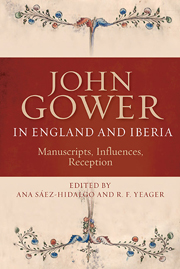Book contents
- Frontmatter
- Contents
- List of Illustrations
- Abbreviations
- Introduction
- I Manuscripts
- II Iberia
- 5 The English Literature of Nájera (1367) from Battlefield Dispatch to the Poets
- 6 At the Nájera Crossroads (1367): Anglo-Iberian Encounters in the Late Fourteenth Century
- 7 Spanish Literary Influence in England: John Gower and Pedro Alfonso
- 8 From Norwich to Lisbon: Factionalism, Personal Association, and Conveying the Confessio Amantis
- III The Classical Tradition
- IV Economy
- V Reception
- Notes on Contributors
- Bibliography
- Index
8 - From Norwich to Lisbon: Factionalism, Personal Association, and Conveying the Confessio Amantis
from II - Iberia
Published online by Cambridge University Press: 05 August 2014
- Frontmatter
- Contents
- List of Illustrations
- Abbreviations
- Introduction
- I Manuscripts
- II Iberia
- 5 The English Literature of Nájera (1367) from Battlefield Dispatch to the Poets
- 6 At the Nájera Crossroads (1367): Anglo-Iberian Encounters in the Late Fourteenth Century
- 7 Spanish Literary Influence in England: John Gower and Pedro Alfonso
- 8 From Norwich to Lisbon: Factionalism, Personal Association, and Conveying the Confessio Amantis
- III The Classical Tradition
- IV Economy
- V Reception
- Notes on Contributors
- Bibliography
- Index
Summary
At an uncertain date, John Gower's Confessio Amantis was translated into Portuguese as O Amante, or Livro do Amante, from what G. C. Macaulay termed a “first recension” manuscript – one which, that is, honored Richard II rather than Henry Bolingbroke. According to the incipit of the manuscript copy of the Confessio's Castilian translation, Confyson del Amante, a rendering from the Portuguese version rather than a Middle English original, the Portuguese translator was one “Roberto Paym,” or Robert Payn, an English-born canon of Lisbon cathedral. Payn was likely the “Ruberte Paym” who appears as a member of the household of Philippa of Portugal in an early fifteenth century document. Philippa (1360–1415), the eldest daughter of John of Gaunt, duke of Lancaster, and Blanche of Lancaster, was queen of Portugal between 1387 and 1415 by marriage to João (John) I. Although some disagreement exists about the precise nature of her involvement, clearly in some capacity Philippa was responsible for the presence of Gower's poem in Iberia, for the appearance of O Amante, and perhaps for offering a copy of it to her half-sister, who sat on the Castilian throne as Catalina of Lancaster. Yet the particulars of the Confessio's Iberian journey, including how and through whom the poem entered the peninsula, are far from resolved.
Despite the significance readily assignable to Anglo-Iberian inter-dynastic relations, to Gower's putative Lancastrian associations, and to Philippa of Lancaster's own lineage, there is serious reason to think that the Confessio came into Philippa's hands from a non-Lancastrian source. Philippa kept several acquaintances in England while queen.
- Type
- Chapter
- Information
- John Gower in England and IberiaManuscripts, Influences, Reception, pp. 131 - 138Publisher: Boydell & BrewerPrint publication year: 2014

